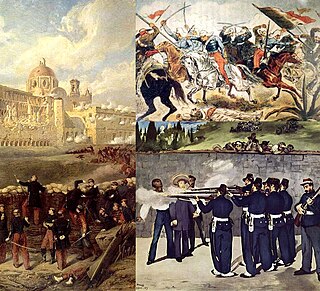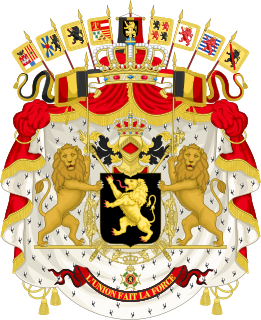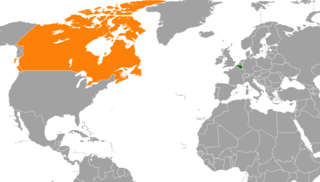This article may contain excessive or inappropriate references to self-published sources .(March 2016) |
Belgian immigrants moved to Wisconsin during the American Civil War.
This article may contain excessive or inappropriate references to self-published sources .(March 2016) |
Belgian immigrants moved to Wisconsin during the American Civil War.
Northeast Wisconsin saw a huge influx of immigrants from Belgium in the mid-1800s. It began in 1852 when two Belgian families decided to make the move to America. They were unhappy with the Belgian monarchy, and sought what is now known as the "American dream." [1] Belgians then flooded Brown, Door, and Kewaunee counties. They settled in communities named after cities in the Old Country, such as Brussels, Namur, and Rosiere. To this day those three counties still hold a significant number of people with Belgian roots.
It was not long before the new immigrants were forced into the major issue facing the United States: the American Civil War. War rosters were first filled by volunteers. When newspapers made more reports of casualties, the number of volunteers fell, forcing states like Wisconsin to start a draft. Belgians thought they were safe because they did not consider themselves citizens, but the government stretched definitions to fit most men. In order for immigrants to get land, they had to sign a "Declaration of Intent" which said they intended to become United States citizens at some point. This made them eligible for the draft. [2]
Each town's assessor was assigned to gather a list of men, age 18-45, healthy enough to fight. Belgian families felt they were unfairly targeted by those in charge of drafts. In Door County, 40 of the 63 men drafted were Belgian. There were options for men to skip the draft, but not many, especially Belgian men, were successful. Doctors were flooded by potential soldiers claiming disabilities, which would allow them to stay home. Among the ailments claimed, there were hernias, lameness, poor sight or hearing, varicose veins and ulcers. In September 1862, Dr. H. Pearce verified disability 246 of the 454 men that sought a way out. Of those, 21 were Belgian. Shortly after, the first Civil War draft in Wisconsin was in November 1862. Finances surely came into play when it came to paying out of the draft as of 1863. Those who were desperate and able would pay $300 to get out of the war. A total of 862 men paid this, with a mere 18 of them being Belgian. The last option was for the draftee to find a substitute. This came into effect in 1864. It was difficult to find someone willing to go to war, but a substitute could have been a full-blooded Native American, a minor, or a non-citizen. [2]
After it seemed to many Belgian people that the draft was fixed, emotions began to run high. One of the biggest issues was the language barrier. Few Belgian immigrants spoke English, therefore could not understand why they were being drafted into a war they had no intent of being a part of. Anger soon overcame these men. They would form marches with clubs, pitchforks and guns. They wanted to see fair enrollment processes. In one of the most explosive demonstrations, colonists formed and marched into the city of [[Green Bay, Wisconsin. They stood outside United States Senator Timothy Howe's home and demanded action. Howe addressed the crowd from his home. But because of the language barrier, the immigrants could not understand, Howe felt threatened and fled the city. Not feeling satisfied, the mob continued to march around the town until they found a fellow Belgian, O.J. Brice. Brice was able to calm the crowd in their native French. He explained that the drafting process would be filled with justice and fairness. The group was satisfied with his explanation in their own language. They then disbanded and returned home without damage or arrests. [2]

The Battle of Puebla took place on 5 May, Cinco de Mayo, 1862, near Puebla de Zaragoza during the Second French intervention in Mexico. French troops under the command of Charles de Lorencez repeatedly failed to storm the forts of Loreto and Guadalupe situated on top of the hills overlooking the city of Puebla, and eventually retreated to Orizaba in order to await reinforcements. Lorencez was dismissed from his command, and French troops under Élie Frédéric Forey would eventually take the city, but the Mexican victory at Puebla against a better equipped force provided patriotic inspiration to the Mexicans.

During the American Civil War, the Union Army, also known as the Federal Army and the Northern Army, referring to the United States Army, was the land force that fought to preserve the Union of the collective states. It proved essential to the preservation of the United States as a working, viable republic.

During the American Civil War, the Union, also known as the North, referred to the United States led by President Abraham Lincoln. It was opposed by the secessionist Confederate States of America (CSA), informally called "the Confederacy" or "the South". The Union is named after its declared goal of preserving the United States as a constitutional union. "Union" is used in the U.S. Constitution to refer to the founding formation of the people, and to the states in union. In the context of the Civil War, it has also often been used as a synonym for "the northern states loyal to the United States government;" in this meaning, the Union consisted of 20 free states and five border states.

In the United States, military conscription, commonly known as the draft, has been employed by the U.S. federal government in six conflicts: the American Revolutionary War, the American Civil War, World War I, World War II, the Korean War, and the Vietnam War. The fourth incarnation of the draft came into being in 1940, through the Selective Training and Service Act. It was the country's first peacetime draft. From 1940 until 1973, during both peacetime and periods of conflict, men were drafted to fill vacancies in the U.S. Armed Forces that could not be filled through voluntary means. Active conscription in the United States ended in 1973, when the U.S. Armed Forces moved to an all-volunteer military. However, conscription remains in place on a contingency basis and all male U.S. citizens, regardless of where they live, and male immigrants, whether documented or undocumented, residing within the United States, who are 18 through 25 are required to register with the Selective Service System. United States federal law also continues to provide for the compulsory conscription of men between the ages of 17 and 45 and certain women for militia service pursuant to Article I, Section 8 of the United States Constitution and 10 U.S. Code § 246.
The Revenue Act of 1862, was a bill the United States Congress passed to help fund the American Civil War. President Abraham Lincoln signed the act into law on July 1, 1862. The act established the office of the Commissioner of Internal Revenue, a department in charge of the collection of taxes, and levied excise taxes on most items consumed and traded in the United States. The act also introduced the United States' first progressive tax with the intent of raising millions of dollars for the Union.

The CICM Missionaries, also known as the Congregation of the Immaculate Heart of Mary, is a Catholic missionary religious congregation for men established in 1862 by the Belgian Catholic priest Theophile Verbist (1823–1868). Its members add the post-nominal letters C.I.C.M to their names to indicate membership in the congregation.

The Second French Intervention in Mexico, also known as the Second Franco-Mexican War (1861–1867), was an invasion of the Second Federal Republic of Mexico, launched in late 1862 by the Second French Empire at the invitation of Mexican conservatives. It helped replace the republic with a monarchy, known as the Second Mexican Empire, ruled by the Mexican Emperor Maximilian I. Mexican monarchists came up with the initial plan to return Mexico to a monarchical form of government, as it had been pre-independence and at its inception as an independent country. They invited Napoleon III to aid in their cause and help create the monarchy, which would, in his estimations, lead to a country more favorable to French interests, but which was not always the case.

Belgian nationality law provides for the conditions in which a person holds Belgian nationality and is based on a mixture of the principles of jus sanguinis and jus soli.
Popular opposition to the American Civil War, which lasted from 1861 to 1865, was widespread. Although there had been many attempts at compromise prior to the outbreak of war, there were those who felt it could still be ended peacefully or did not believe it should have occurred in the first place. Opposition took the form of both those in the North who believed the South had the right to be independent and those in the South who wanted neither war nor a Union advance into the newly declared Confederate States of America.
Belgian Americans are Americans who can trace their ancestry to immigrants from Belgium who emigrated to the United States. While the first natives of the then-Southern Netherlands arrived in America in the 17th century, the majority of Belgian immigrants arrived during the 19th and 20th centuries.
German-Americans were the largest ethnic contingent to fight for the Union in the American Civil War. More than 200,000 native-born Germans, along with another 250,000 1st-generation German-Americans, served in the Union Army, notably from New York, Wisconsin, and Ohio. Several thousand also fought for the Confederacy. Most German born residents of the Confederacy lived in Louisiana and Texas. Many others were 3rd- and 4th-generation Germans whose ancestors migrated to Virginia and the Carolinas in the 18th and early 19th centuries.

Foreign enlistment in the American Civil War (1861–1865) reflected the conflict's international significance among both governments and their citizenry. Diplomatic and popular interest were aroused by the United States' status as a nascent power at the time, and by the war's central cause being the globally divisive issue of slavery. Consequently, many men enlisted from abroad and among immigrant communities in the U.S. When hostilities first broke out, roughly 13% of Americans were foreign-born, the vast majority concentrated in northern cities; subsequently, foreign enlistment largely favored the Union, which was also far more successful at attracting volunteers.
The 5th Wisconsin Infantry Regiment was an infantry regiment that served in the Union Army during the American Civil War.
The 7th Wisconsin Infantry Regiment was an infantry regiment that served in the Union Army during the American Civil War. It was a component of the famous Iron Brigade in the Army of the Potomac throughout the war.

With the outbreak of the American Civil War, the northwestern state of Wisconsin raised 91,379 soldiers for the Union Army, organized into 53 infantry regiments, 4 cavalry regiments, a company of Berdan's sharpshooters, 13 light artillery batteries and 1 unit of heavy artillery. Most of the Wisconsin troops served in the Western Theater, although several regiments served in Eastern armies, including three regiments within the famed Iron Brigade. 3,794 were killed in action or mortally wounded, 8,022 died of disease, and 400 were killed in accidents. The total mortality was 12,216 men, about 13.4 percent of total enlistments.

The Enrollment Act of 1863 also known as the Civil War Military Draft Act, was an Act passed by the United States Congress during the American Civil War to provide fresh manpower for the Union Army. The Act was the first genuine national conscription law. The law required the enrollment of every male citizen and those immigrants (aliens) who had filed for citizenship, between 20 and 45 years of age, unless exempted by the Act. The Act replaced the Militia Act of 1862.

The United States and Belgium maintain a friendly bilateral relationship. Continuing to celebrate cooperative U.S. and Belgian relations, 2007 marked the 175th anniversary of the nations' relationship.

Belgium–Canada relations are those between the nations of Belgium and Canada. Both are close allies and members of NATO and Francophonie. Both have a stance of multilateralism. The two nations have official bilingualism, and similar federal government systems owing in part to language tensions in both. Both were actively involved in the war in Afghanistan under ISAF.
Irish-American Catholics served on both sides of the American Civil War (1861–1865) as officers, volunteers and draftees. Immigration due to the Irish Great Famine (1845–1852) had provided many thousands of men as potential recruits although issues of race, religion, pacifism and personal allegiance created some resistance to service. A significant body of these veterans later used the military experience gained in the war to launch several conflicts with the goal of establishing an independent Irish Republic as members of the Irish Republican Brotherhood, the Fenian Brotherhood and Clan na Gael.

Czech Texans are residents of the state of Texas who are of Czech ancestry. Large scale Czech immigration to Texas began after the Revolutions of 1848 changed the political climate in Central Europe, and after a brief interruption during the U.S. Civil War, continued until the First World War. Concentrated in Central Texas, Czech Texans have preserved their identity through the Painted Churches of Texas, traditional Czech events, and bakeries specializing in Czech pastries.